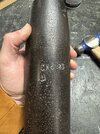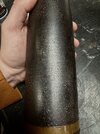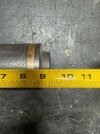HoldThePickle24
Active Member
Hi everyone, thanks for allowing me to join the forum. I’m trying to identify this strange projectile. It’s just about 76mm, it has a flat/flush drive band, and a little protruding cavity at the base. It also has a few stamps, including the broad arrow. It also has “CX6 96” stamped on it.
A pretty knowledgeable friend thinks it’s an early 13pdr shell. After he suggested that, I took the No.85 fuze off an13pdr I have and it does fit the threads or this shell. He said it would go to the first iteration of the 13pdr gun which was a bag gun. He never really explained what the cavity on the back would be though.
Anyway, any thoughts or insights from the group members would be appreciated!
A pretty knowledgeable friend thinks it’s an early 13pdr shell. After he suggested that, I took the No.85 fuze off an13pdr I have and it does fit the threads or this shell. He said it would go to the first iteration of the 13pdr gun which was a bag gun. He never really explained what the cavity on the back would be though.
Anyway, any thoughts or insights from the group members would be appreciated!
Attachments
Last edited:















